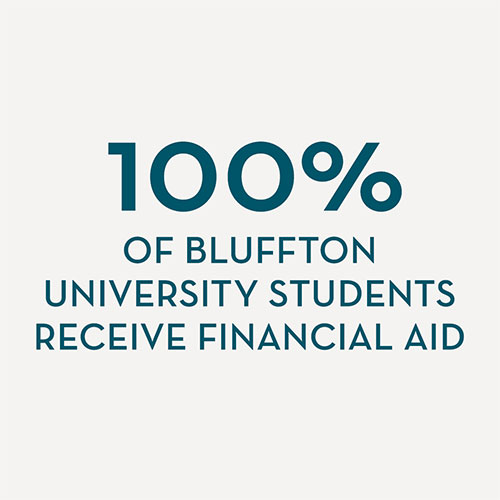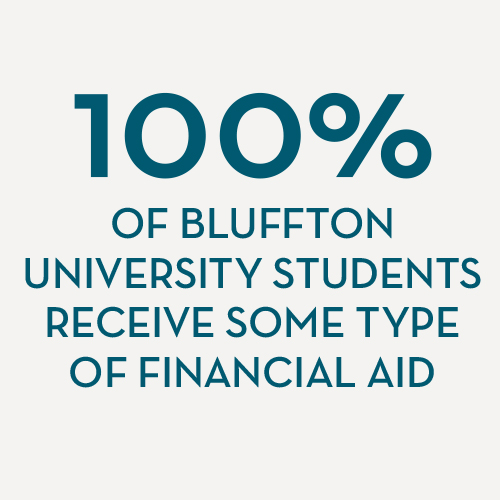


Consumer information
General information
Parents (of dependent students), to the extent that they are able, have the primary responsibility to pay for their child's education. Students are also expected to contribute to their educational costs. Eligibility for federal grants and loans and state need-based grants is determined by filing the Free Application for Federal Student Aid (FAFSA). Bluffton University also requires the FAFSA to determine eligibility for need-based institutional aid.
Contact information Financial aid and a student's financial need vary considerably. Students are encouraged to discuss their specific needs with a financial aid representative. Office hours are from 8 a.m. -12 p.m. and 1-5 p.m. Monday through Friday.
Application procedures
Students seeking financial aid are required to complete and submit the Free Application for Federal Student Aid (FAFSA) annually. The federal school code for Bluffton University is 003016. A financial
aid award notice is generated and sent to the accepted student when FAFSA data is
received and any other required documentation is on file.
Deadlines
Students should be aware of application deadlines established by off-campus sources
of aid including state and federal agencies. These deadlines are announced about one
year before the beginning of the academic year.
Because of limited resources, the State of Ohio maintains an October 1 deadline for Ohio need-based aid (the Ohio College Opportunity Grant). Bluffton University need-based aid is also limited. Therefore, Bluffton University maintains a FAFSA priority deadline of May 1 for both new and returning students. This means that any accepted, first-time or returning student filing the FAFSA after May 1 could be denied need-based funds administered by Bluffton University if funds have been depleted. This May 1 priority deadline is in effect for federal campus-based programs (SEOG grants and federal work-study) and for Bluffton University need-based grants.
For additional information on the application procedure see Apply for aid.
Financial need A student's financial need is determined by subtracting the Expected Family Contribution
(EFC as determined by the FAFSA) from Bluffton University s Cost of Attendance (COA).
COA includes direct costs such as tuition, fees, room and board (if applicable) and
indirect costs or personal expenses. For the 2022-23 academic year the following indirect
costs/personal expenses apply:
| Residential students | Dependent commuter | Independent commuter | |
|---|---|---|---|
| Books and supplies | $1,400 | $1,400 | $1,400 |
| Personal expenses | $1,600 | $1,600 | $2,600 |
| Transportation | $1,150 | $1,850 | $1,850 |
| Room and board | $2,680 | $8,930 | |
| Total | $4,150 | $7,530 | $14,780 |
Financial aid programs
Bluffton University administers financial assistance through scholarships, grants,
loans and student employment programs. Scholarships are usually awarded on the basis
of academic achievement. Grants and loans are awarded on demonstrated financial need
and or remaining costs.
Bluffton University scholarships and grants
Bluffton University offers many different scholarships and grants. A complete listing
of these can be found at Bluffton scholarships and grants. Bluffton University grants and scholarships are awarded for a maximum of four years
(eight semesters) except where noted.
Renewal policy for Bluffton University scholarships/grants:
Students receiving a Bluffton University scholarship and/or grant that has a GPA requirement
for renewal, must maintain the minimum GPA to continue to receive that scholarship
or grant. Scholarships or grants that are awarded based on participation in a program
or specific major of study may have additional requirements for renewal. A student
who falls below the requisite GPA for scholarship renewal at the end of an academic
year will continue to receive the award during a scholarship grace period and this student will continue to receive the scholarship in subsequent semesters
as long as the cumulative GPA goes up. If/when the requisite GPA for renewal is reached,
the scholarship is fully reinstated. If at the end of any semester during a scholarship
grace period the cumulative GPA does not go up, the scholarship is lost. A student
also has the option to appeal the loss of a scholarship based on documented extenuating
circumstances.
Student employment
Bluffton University has a wide variety of student employment opportunities available
to students through the Learn and Earn Program. Students are paid monthly for working
on campus. Complete information about terms of employment is provided with the student
employment work agreement. The federal programs including federal work-study, community
service, America Reads and America Counts are all administered under the Learn and
Earn Program at Bluffton University. More about campus jobs...
State grant and scholarship programs
A complete list and description of Ohio financial aid programs can be found at: www.regents.ohio.gov/sgs/.
Federal aid programs
The following federal programs are administered by Bluffton University: Federal Pell Grant, Federal Supplemental Education Opportunity Grant (SEOG), and the
TEACH Grant. For additional information and eligibility requirements for these programs go to Federal grants
Federal student aid and drug law violations
Federal regulations dictate that a student is ineligible to receive federal student
aid if the student is convicted of a drug-related felony or misdemeanor that took
place while the student is receiving federal student aid.
Loan programs
Federal Direct Loan program
The Federal Direct Loan Program offers low cost loans to students. Subsidized loan
amounts are calculated on need as determined by the FAFSA. Unsubsidized loans are
not need-based. For additional information on annual loan limits, interest rates,
etc. see Loans.
Federal Direct Parent PLUS Loan
The Federal Direct PLUS Loan allows for parents to borrow up to the student's cost
of attendance, minus other financial aid. Parents can apply on-line and must complete
an application and Master Promissory Note (MPN) for each dependent student for whom
they are applying. For more information on PLUS loans see Loans.
Private education loans
Several lending institutions offer private education loans to students and families.
Various options and terms apply which should be weighed carefully before any commitment
is made. A loan comparison tool is available online.
Loan funds are disbursed to the student's account at the beginning of each semester or in a timely manner if the loan has been certified after a term has started.
Disbursement of financial aid and billing
Prior to each semester, the business office issues billing statements. (Please note
that unless prior arrangements are made, billing notices are sent to the student and
not the parents.) The statements include charges for that semester and any outstanding
charges to a student's account. Aid is disbursed to students through the business
office by crediting the student's account with the attributed amount of aid at the
beginning of each billing period. The balance due can be paid in full or through
the university's payment plan. For more information on payment plans or business office
procedures contact the business office at 419-358-3301.
Satisfactory academic progress
Bluffton University monitors student progress toward a degree on a per-term and annual
basis for academic and financial aid purposes. Students who meet regular academic
requirements for continuing their enrollment are eligible for financial aid. For a
complete review of Bluffton University's Satisfactory Academic Progress see the Bluffton University Catalog.
Refund policy
All courses dropped the first two weeks of classes will receive a 100 percent refund. During each consecutive week, the refund is reduced by 25 percent each week. After the fifth full week of classes, no refund is granted. Example:
- Until the expiration of the add/drop period: 100% of tuition and fees.
- After the add/drop period, the student refund is reduced by 25% of tuition for each week thereafter.
- After the 2nd full week of class up to the third full week of class - 75% of tuition
- After 3rd full week of class and up to the fourth full week of class - 50% of tuition
- After 4th full week of class and up to the fifth full week of class - 25% of tuition
- After the 5th full week of class: No refund
Meal plans: Following the add/drop period, cancellation of a meal plan will result in a $100 charge and the meal plan will be refunded on a prorated weekly basis (Sunday – Saturday) through the 3rd full week of class. Thereafter, no refund will be administered.
Students with special circumstances who intend to return to the university in the following semester may submit a written appeal to cashier@bluffton.edu. Student refunds for approved student appeals will follow the federal financial aid refund policy.
The Bluffton University financial aid office is responsible for calculating the percentage of earned aid for the semester and for returning the unearned aid to the state and institutional aid programs. The financial aid office will perform this calculation within 45 days of the student's withdrawal date. The length of the period or semester is based on Bluffton's published academic calendar, including weekends and excluding scheduled breaks of 5 days or more. The first day begins on the first day of classes and ends on the last day of final exams.
Note that students who are Title IV (federal aid) recipients will have the return of those funds and repayments calculated and distributed as prescribed by federal law and regulation (see Return of Title IV Funds Policy). These distribution schedules are available to all prospective and currently enrolled students by contacting the business office or the office of financial aid.
Return of Title IV funds policy
Any student who withdraws * from Bluffton University prior to completing 60 percent of the payment period (i.e. semester) (see Refund Policies, University Catalog) may have their federal aid recalculated and a portion returned to the federal government according to regulations prescribed by law. Students who withdraw before the 60 percent period in time will have a pro-rated amount of their federal Title IV aid returned to the aid program by the school and possibly by the student. Students who withdraw after the 60 percent period of time in the semester will have earned 100 percent of their financial aid and will not have a refund calculated. This policy meets federal requirements in which students earn financial aid based on the percent of the term completed (see 34 CFR, Section 668.22 of the Title IV Higher Education Act of 1965, as amended).
The Bluffton University financial aid office is responsible for calculating the percentage of earned aid for the semester and for returning the school’s portion of unearned aid to the federal aid programs. The financial aid office will perform this calculation as soon as possible but no later than 30 days from the date it was determined the student withdrew **. This calculation is measured by dividing the number of days the student attended by the total number of days in the payment period. The length of the payment period (i.e. semester) is based on Bluffton’s published academic calendar, including weekends and excluding scheduled breaks of 5 days or more. The first day begins on the first day of classes and ends on the last day of final exams.
The amount of earned federal aid (other than work study) is calculated by taking the total of aid disbursed and amount of aid that could have been disbursed for the semester multiplied by the percentage of earned aid. If the amount of aid earned for the semester is greater than the total amount of aid disbursed, then the student may be eligible for a post-withdrawal disbursement (see post-withdrawal disbursement guidelines). However, if the amount of aid earned for the semester is less than the total amount of aid disbursed, then a refund of unearned aid, also called an over-payment, is due to the Department of Education. The amount of unearned aid is equal to the total federal aid that was disbursed minus the amount earned by the student. The school’s portion is calculated by multiplying the institutional charges for the period by the percentage of the term not completed. The student’s portion is calculated by subtracting the amount the school is responsible to return from the total amount of unearned aid. Federal monies the school is responsible for will be returned as soon as possible but no later than 45 days from the date it was determined the student withdrew, and will be returned in the following order: Federal Direct Unsubsidized loan, Federal Direct Subsidized loan, Federal Perkins loan, Federal Direct Parent PLUS loan, Federal Pell grant, Iraq and Afghanistan Service Grant, Federal SEOG grant, Federal TEACH Grant.
As outlined in the previous paragraph, the return of Title IV calculation could result in the student’s overpayment in one or more of the Title IV programs. Students in an overpayment situation will be notified in writing as soon as possible but no later than 30 days from the date it was determined the student withdrew. Students with an overpayment resulting from federal loans will be notified to repay the loan holders according to the terms of the borrower’s promissory note. Students with an overpayment resulting from federal grants will be responsible to the school to make restitution for the overpayment. The student will have 45 days from the date they have been notified to repay the overpayment or make satisfactory arrangements to repay it. The notification will include additional disclosures, including consequences of not making restitution for the overpayment. Overpayment of federal grants will be returned in the following order: Federal Pell grant, Iraq and Afghanistan Service Grant, Federal SEOG grant, Federal TEACH Grant.
If a Title IV refund amount is owed to the student, but the student has outstanding institutional charges, or if the student owes a repayment of a cash disbursement for non-institutional costs, the university will automatically apply the refund amount to those charges or repayment (after obtaining written permission from the student). Bluffton will also notify the student in writing if either situation has occurred.
If all the funds the student earned were not yet disbursed to the student's account before the student withdrew, the student may be due a post-withdrawal disbursement. If the post-withdrawal disbursement includes grant funds, the Financial Aid office will automatically disburse the portion of these funds required to cover any outstanding tuition, fee, room and board charges at Bluffton University. Note that non-institutional charges (e.g., a library fine) will only be covered if written permission is obtained from the student. If no outstanding institutional charges exist, the grant disbursement will be sent to the student within 14 days of the post-withdrawal disbursement.
If the post-withdrawal disbursement includes loan funds (including a Federal Parent loan), the Financial Aid office will notify the student (or parent) and provide him or her with the option to accept all or a portion; or decline all of the loan funds.
If the student (or parent) responds and gives permission, the Financial Aid office will disburse the loan funds to cover any outstanding tuition, fee, room and board charges at the University (or non-institutional charges with written permission). If the student responds and declines permission, the loan funds eligible to be disbursed as a post-withdrawal disbursement will be offered to the student. If the student does not respond within 14 days from the date of being notified, the loan funds will be cancelled.
Students who are Title IV (federal aid) recipients will have the return of those funds and repayments calculated and distributed as prescribed by federal law and regulation. These distribution schedules are available to all prospective and currently enrolled students by contacting the business office or the office of financial aid.
*To officially withdraw, a student must contact the registrar's office. The registrar's office determines the official date of withdrawal.
**When it is determined that a student has stopped attending classes and has withdrawn (officially or unofficially), the Registrar contacts the instructors for that student to determine the last date of attendance (LDOA) in each class. The latest date of attendance then is the withdrawal date used for both official and unofficial withdrawals. At the end of a term, if a student has E’s in all of his or her classes, the Registrar contacts the instructors for that student to determine if the student completed the term in at least one class.
The information above is for the 2023-24 academic year and is subject to change for subsequent years

